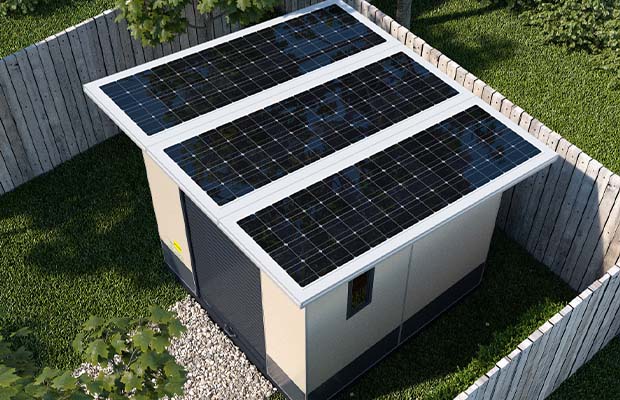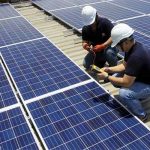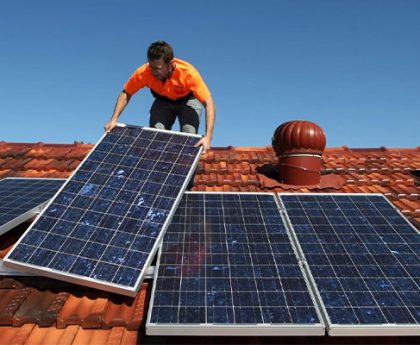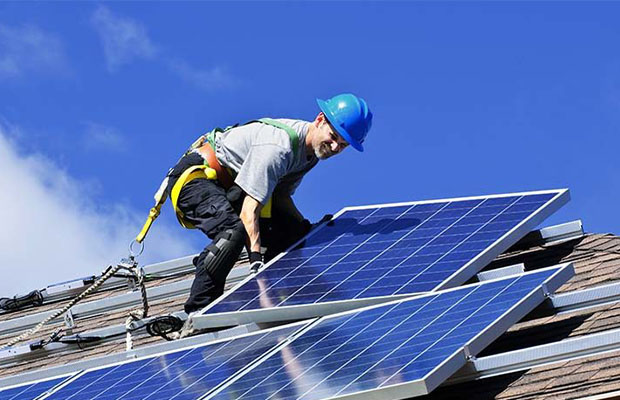Do you have a shed or other outbuilding that needs lighting and/or electricity? Running an underground cable from your home to the structure is frequently the most cost-effective option.
Solar power for sheds is gaining popularity. Due to their affordability and environmental friendliness, this is understandable. However, they still offer an electrical supply, so you must take care to follow all the necessary steps.
Maybe you’re wondering if it’s even worthwhile to install solar panels in your shed. Here, we’ll go over all the factors to take into account before installing solar panels on your shed.
Related Reading: Solar Panel For Gazebo
Table of Contents
- What Is A Solar Shed?
- Ac Vs. DC Solar Sheds
- Importance Of Solar Power For Shed
- Pros & Cons Of Solar Power For Shed
- Solar Shed Size And Structure
- Sunlight Exposure
- Cost Considerations On Solar Power For Shed
- Thing You Need To Build A Solar Shed?
- How To Build A Solar Power For Shed?
- How Much Roof Space Do Solar Panels Require?
- Is It Worthwhile To Install Solar Panels On Shed?
What Is A Solar Shed?
A solar shed is a workshop or other outbuilding outfitted with a solar system that harnesses energy from the sun and stores it in batteries. The system then provides electricity for shed-related needs like lighting, outlets, chargers, or power strips for corded power tools.
Ac Vs. DC Solar Sheds
There are two types of solar energy that can power a shed: DC current for small power requirements and AC current for larger requirements.
AC Systems
The second tier of solar sheds costs from $3,000 to $5,500 for a robust alternating current (system with a power output of 400 to 800 watts, respectively. Systems at either end of this spectrum are capable of supplying power for corded electric benchtop tools, shop and area lights, and the recharging of cordless tools.
DC Systems
The first tier is a basic direct current (DC) solar system that costs $100 to $200 and has one or two panels sufficient to power a couple of low-voltage lights.
The installation and understanding of this kind of solar shed power system are both straightforward. However, nothing plugged in or with a cord can be powered by this system. That is not how it is intended to be used, and it cannot be changed to do so.
Sheds
If you already own a shed with a sizable south-facing roof, you can outfit it with solar system components to make it a solar shed. For a basic 10-by-12-foot shed, kits that include all the pieces (unassembled) start at $3,300.
Larger 12-by-16-foot sheds with windows and other stylistic touches cost from $8,500 to $12,000.
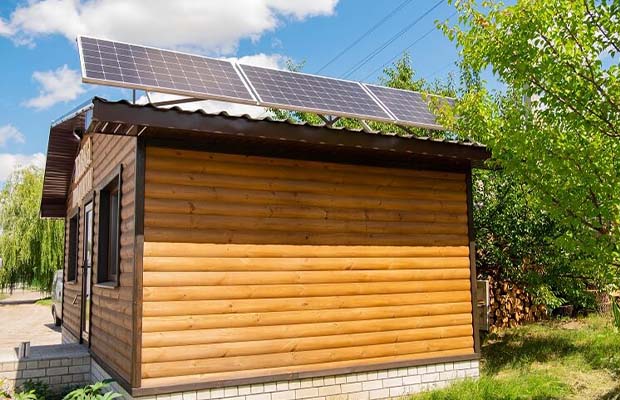
Importance Of Solar Power For Shed
Most of the time, a solar shed won’t be able to meet all of your household’s electricity needs. So why even consider purchasing solar panels for your shed? Here are a few important factors to take into account.
Create A Virtual Power Plant
Store excess electricity in a solar+storage battery so that you can participate in a “virtual power plant,” where individual homeowners aggregate their solar batteries and sell energy to their electric utility. When electricity demand is at its highest and prices are high, the electricity you’ve stored in your battery can make you money.
Supplement An Existing System
Solar panels are a long-term investment, lasting 25 years or longer1. While this may be adequate for some, others’ needs for electricity may change during that time.
Installing solar panels on a shed roof can help provide any additional needs, whether your family is growing or you’ve changed to working full-time from home.
Heat Additional Structures
A three-season building may become a four-season one by providing energy to heat an outbuilding, such as a greenhouse or the shed itself. Use a heated greenhouse to grow your own food all year long or convert a shed into a year-round studio for your art.
Charge An Electric Vehicle
Your shed’s roof can serve as a charging station for electric vehicles (EVs). Your electric vehicle (EV) may receive solar energy directly or it may store it in a battery for later use.
Store Emergency Power
You might prefer to produce enough electricity to store in a battery backup system rather than a full rooftop solar system to power your home. For that, you could use a solar shed.
Pros & Cons Of Solar Power For Shed
Before installing any kind of solar energy in your shed (or log cabin or summerhouse), you need to weigh up the pros and cons:
Pros
- Reduces operating costs
- Good return on investment
- Eco-friendly
- Gives you some control over your energy bills
- Backup energy in outages
- Less wire use and maintenance
Cons
- Expensive initial investment
- Your shed must strong enough to take the extra weight (solar panels)
- The panels need to face south, east, or west (ideally south)
Solar Shed Size And Structure
If you know your “why” for a solar shed, you can move on to specifics. The first query is how many solar panels are required for the shed roof.
Take into account that the typical solar panel is 5′ x 3′.2 A relatively large 10′ x 12′ shed with a roof has a minimum of 120 square feet, which can accommodate six to eight standard solar panels.
The structural suitability of your shed is also crucial to take into account because solar panels may be too heavy for it to support. If you’re unsure, you can ask a solar installer or structural engineer to assess whether your roof is sturdy enough to hold solar panels.
Sunlight Exposure
The availability of sunlight and its intensity affect solar panel efficiency in part.
The benefit of receiving more sunlight throughout more hours of the day may be a benefit of a gabled roof. The middle of the day is when the sun is strongest, which a flat roof can fully take advantage of. It might turn out that your shed gets more sunlight than your house, which would make it a better choice.
On the other hand, obstacles—like other structures and tree limbs—might impose restrictions. You can decide whether a solar shed is beneficial based on whether these obstructions are removed.
Cost Considerations On Solar Power For Shed
Installation and the solar panels themselves are the project’s two biggest expenses.
You should work with a solar installer who has prior experience collaborating with your local utility during the inspection and connection process if you intend to connect the solar panels on your shed to the grid. Even though big-box home improvement stores and the internet both sell solar kits, we advise hiring an electrician if you are unsure how to install solar panels.
Wires must be run from your shed to your home, where your electricity meter is most likely located if you intend to use the extra electricity for your home. This might entail spending more money to bury the wiring in electrical conduits.
Your initial outlay will be higher as your project grows, but you are more likely to recoup your costs. Since solar panels have become more affordable over the past ten years, the majority of your installation costs will be labor, licenses, and other business expenses. Investing in a rooftop solar system that can handle your household’s energy needs might be more cost-effective.
Federal financial aid is available for solar panel installation. However, keep an eye on federal legislation because this could change, hopefully for the better. Tax credits and rebates are available in many states as well.
Thing You Need To Build A Solar Shed?
- Shed: The shed’s roof must be large enough for several connected solar panels, and it must face south (or in the direction of the local sun). The bare minimum required to accommodate four 100-watt AC solar panels is a shed measuring 120 square feet.
- Photovoltaic panels: The roof of the shed has solar panels that capture sunlight permanently.
- Charge controller: The charge controller, which is housed in the solar shed, receives power from the photovoltaic panels. The charge controller maintains the batteries’ optimal performance by controlling the flow of electricity into them.
- Fuse box: The fuse box is a safety feature that offers the user a way to stop the flow of electricity if necessary so they can repair the system.
- Batteries: Batteries are used to store the electricity generated by solar systems until it is needed. Usually, multiple batteries are needed.
- Inverter: Using alternating current (AC) devices, such as corded tools, requires an inverter because the power that emerges from the batteries is direct current (DC).
- Power strip or outlet: For plugging in tools or lights, batteries are fed into a power strip or outlet.
How To Build A Solar Power For Shed?
- For mounting and storing all of the solar parts, construct a sturdy support wall inside the shed.
- To store the batteries, construct a sizable, well-ventilated box on the floor.
- Connect the two components after mounting the fuse box and charge controller on the support wall.
- Connect the inverter to the fuse box and charge the controller after mounting it on the support wall.
- Make sure the roof connections are waterproof to prevent water intrusion before adding the two parallel rails supporting the solar panels to the shed roof.
- A small conduit hole should be made on the roof.
- Install a metal conduit that goes from the solar system’s parts on the wall support to the roof.
- Place an electrical box at the conduit’s top end on the roof.
- Near the solar shed, drive a grounding stake into the ground.
- Install a wire connecting the fuse box and the grounding stake.
- Put the solar panels on the railing supports.
- Run the wires through the conduit and up through the roof hole.
- The solar panels should be wired.
How Much Roof Space Do Solar Panels Require?
You should keep in mind, though, that if you want to live in your garden building, you’ll need enough shed roof space for all the solar panels you’ll require. For instance, suppose you live in a garden building and require 4kW of power daily.
In that case, you would require 16 (sixteen) 250W solar panels, each taking up 25.6m² of space on your roof. As a result, a structure like an Omega log cabin would be a better choice (for offering sufficient power for a live-in shed) than, say, a structure made to be a storage shed.
Is It Worthwhile To Install Solar Panels On Shed?
The question of whether it is worthwhile to use solar power to power a shed in the UK is a valid one, even though it is now obvious that you can do so. Here are some of the factors you need to consider:
- What you use your shed for
- How much power you need
- The size and age of the shed
- The strength of the roof
- The position of the building
- Your budget
In terms of how you use or plan to use your shed if you spend a lot of time there and require electricity to run lights, appliances, a gym shed, or garden office equipment, solar panels might be a cost- and environmentally-friendly substitute for mains power. especially if you require solar panels for, say, lighting a summerhouse or heating a shed. Similarly, how you use the shed will determine how much solar energy you require (more on this in the section after this). The durability and age of your garden building will also factor into the decision of whether it is worthwhile to install solar panels on it. For instance, installing solar panels on an outdated shed with a flimsy or sunken roof is pointless unless you replace the shed (or another type of garden building) entirely.
Read More: Solar Shades Vs Roller Shades

